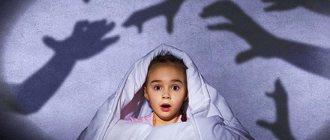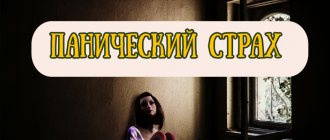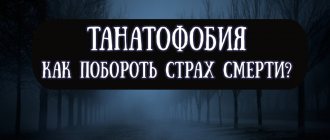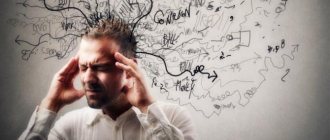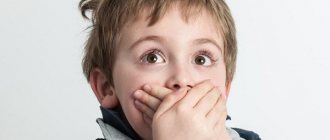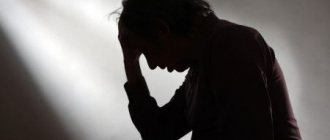The ancient Roman poet Publilius Syrus rightly noted that “the fear of death is worse than death itself.” Any person suffering from vegetative-vascular dystonia will easily agree with him, and will even make a small amendment to the statement: the fear of death with VSD is so much worse than death itself that all life seems like useless suffering. VSDers are so tired of their own heads and uncontrolled phobias that they sometimes envy animals and their blissful ignorance.
From the outside, such behavior may seem strange, illogical, unhealthy (which is to some extent justified). A person who has never encountered VSD, neuroses and panic states is simply not able to let through all the horror that a VSD sufferer experiences every day. “Stop it, I got it!” It would be better to go and have a walk with friends than to sit within four walls and fill your head with nonsense!” - this is what VSD residents regularly hear from their households. And the helplessness only intensifies.
“No one can save you: neither doctors, nor loved ones. Nobody believes me!
Why does the fear of death arise in VSD?
Fear of sudden death - thanatophobia - is not such a rare phenomenon. This phobia has manifested itself in people at all times, and not only among VSD people. The causes of thanatophobia have not been fully studied, but it has already been revealed that an obsessive fear of death occurs in overly impressionable, suspicious people, those who suffer from hypochondria and think a lot about the future.
The trigger for the development of a phobia can be the tragic death of a friend or loved one, a midlife crisis with a reassessment of life priorities, or an excess of negative information from the Internet or television.
The fear of death with VSD usually starts during the first panic attack in life. Even if the patient’s psyche heroically withstands an unfamiliar state, the thought is forever deposited in the subconscious: I almost died once... Many VSDs remember their first panic attack as a tragic event (accident, fire, injury).
If a panic attack occurs for the first time in a teenager, it is especially difficult for him to adequately respond to this painful condition. After all, everything was fine just recently. Yes, my head was spinning, my pulse sometimes quickened, but it didn’t frighten me so much. And when the body suddenly trembled, as if pierced by electricity, the legs and arms became cold, and the heart beat in every vein and in the ears - the patient was not just scared, he succumbed to panic, completely immersed in the adrenaline that was walking through the blood. And the ambulance, encouraging me, said that at that age they don’t die.
Other reasons
Fear of death can be caused not only by anticipation of the unknown, fear of suffering or pain, fear for loved ones, but also by other reasons.
The most common are:
| Periods when a person moves from one phase of life to another |
|
| High levels of anxiety that make you fear death |
|
| Crisis of religious beliefs |
|
| Loss of position in society, financial well-being and health |
|
How does a phobia of death develop in VSD?
Remaining in the subconscious, the obsessive fear of sudden death was reinforced every day, every month and year - either someone’s death would be shown on the news, or a tragedy would happen in the family of friends, or the patient himself would begin to grind in his memory all his feelings and thoughts during the crisis. Subsequent panic attacks - and they no longer leave you alone - only add fuel to the fire.
Each time the VSD member fears more and more for his life. He turns into a hypochondriac: he begins to read tons of information about heart disease, attacks, strokes, “try on” the symptoms for himself and, surprisingly, find similarities. Now he considers any burning sensation behind the sternum to be the beginning of a heart attack. Stumbling over a threshold means a stroke, loss of coordination. Periodically, the patient even checks himself for the presence of a stroke: he raises both arms, smiles in front of the mirror - God forbid he notices some kind of asymmetry.
Measuring your heart rate has now become commonplace - like brushing your teeth, only more often. Much more often. Instead of human friends - a tonometer, Corvalol, Anaprilin, bookmarks on medical forums. Therapists, paramedics, and household members can refute the patient’s suspicions as much as they like. But VSD and obsessive thoughts about death are inseparable concepts.
Drug therapy
It is useless to treat an incipient attack with medications. None of them can instantly suppress symptoms. The exception is drugs for intravenous administration, for example, Diazepam (Relanium, Seduxen). It and similar drugs help to cope with panic, but for this they call an ambulance.
The effect of the drug begins after 20 minutes, when PA regresses naturally.
In order to shorten attacks, the patient is prescribed the following:
- Anaprilina;
- Corvalola;
- Validola.
These medications are prescribed by your doctor when panic attacks occur frequently. These medications have a sedative effect. With their help, the activity of the nervous system is inhibited. Anaprilin is able to suppress redness, heat, tachycardia and break the vicious circle.
The courses are assigned:
- tranquilizers,
- antidepressants,
- beta blockers.
Some drugs in these groups cause side effects. Therefore, they are prescribed in rare cases. Beta-blockers have a gentle effect. They block the release of adrenaline into the blood. This leads to a decrease in the intensity of panic attacks.
How to overcome the fear of death with VSD
If dystonia is not a disease, then thanatophobia is a real mental disorder, and it requires action. The therapist is powerless here; we need a psychologist, and in severe cases, a psychiatrist who will prescribe anti-anxiety medications.
While the fear of sudden death has not yet taken on a severe form, VSD members can hotly discuss it on their forums, even make fun of each other. But if even some random user “dare” to make a joke or remark, they will attack in a crowd and peck you away.
After all, deep down in their souls, they understand perfectly well that they still haven’t coped - and, perhaps, they won’t cope anymore. Some may have the illusion of control over their phobias, but how colorfully it breaks on the next iceberg of a panic attack.
What does the obsessive fear of death lead to in VSD when it takes on a severe form?
- Obsessive-compulsive disorder, which torments the patient with its “rituals.” Example: a patient has a momentary thought that if he does not touch the exit door with his forehead three times, he will die in the evening. The thought is so obsessive that a person does not have a single chance to resist it. He goes and touches his forehead to the door. Okay, but what if this happens at work, at a bus stop, in a store in front of a window? Some find it funny, but others actually perform these rituals to the detriment of their own reputation!
- A person rearranges his life so as to keep pace with his phobia. He stops communicating with many friends, avoids contact with people, and practically does not leave the house: after all, death awaits on every corner.
- If a person is afraid that he will die from some fatal disease, then he can literally not leave the hospital and undergo endless examinations. In severe cases, a person is afraid to end up in a place that is difficult to reach for an ambulance, for example, outside the city.
- Everyday chores and work become an overwhelming burden, taking more and more energy. Man is unable to do simple things.
- Stress changes many organic functions, health deteriorates sharply, and panic attacks occur more often than usual. This stress causes chronic fatigue and depression.
Therefore, it is very important not to start the problem. And as soon as it appears, immediately contact a psychologist. The sooner you start working with a psychologist, the easier it will be to overcome the fear of sudden death.
Clinical manifestations
The reaction of the human body during PA is similar to the symptoms of more serious diseases. Vegetative dystonia with panic attacks is characterized by:
- increased heart rate or tachycardia;
- tremor;
- chills;
- dizziness;
- lack of air;
- pain in the heart area;
- shortness of breath.
There is panic. The patient feels as if he is about to lose consciousness. Sometimes thoughts get confused. The attacks are caused by traumatic moments, the existence of which the patient knows and always tries to avoid.
- Teenagers suffering from VSD become irritable, quickly get tired, and complain of causeless weakness. The attack comes suddenly. The feeling of heat is accompanied by a strong heartbeat. The duration of one attack is about 10 minutes. Typically, anxiety attacks occur at night.
- The patient's arms and legs go numb. Smooth muscle spasms occur in the stomach and intestines. Some guys feel sick and vomit. These symptoms are sometimes combined with involuntary urination. There is a strong fear of death.
Frequent panic attacks are fraught with suicide attempts. If an attack of PA occurs in front of people, the psychological state of the patient is aggravated, as well as the feeling of personal inferiority.
Sometimes panic attacks manifest themselves as painful sensations of varying localization and intensity. Headache is present constantly or periodically. Atypical manifestations are accompanied by mental disorders resembling seizures.
As time passes, attacks occur more frequently. Agoraphobia develops (fear of being in open places where no one will provide help). Signs of dysfunction of the gastrointestinal tract appear, and dyspeptic disorders occur. Skin tone changes. In women, pinkish or reddish nerve spots form. They are localized on the neck or chest. The attacks are accompanied by a feeling of a lump in the throat.
Causes and mechanism of development of VSD
Diagnostic studies indicate that this set of symptoms is a consequence of an imbalance in the functioning of the autonomic nervous system. Unlike the somatic nervous system, which is controlled by consciousness and reason, the autonomic nervous system works without our participation. This is the regulation of breathing, heart contractions, focusing of vision and other basic functions of the body depending on environmental conditions: for example, accelerating the reaction and increasing the heart rate in extreme conditions or slowing down breathing and relaxing muscles during sleep. This part of the nervous system always works: from the moment a person is born and literally until death.
Among the factors that provoke this disorder are the following:
- Heredity. It is known that disorders of the nervous system are often inherited, and dystonia is no exception. If someone in the family suffered from emotional lability, increased anxiety, spontaneous fears, then the next generations are at risk.
- The period of hormonal changes. The time when the body experiences a restructuring of the endocrine system (adolescence, pregnancy, childbirth, constant severe stress, etc.) becomes fertile ground for the manifestation of symptoms of NCD. Against the background of hormonal imbalance, sudden surges and decreased activity of the endocrine glands, people often experience the above-described sensations to varying degrees of severity.
- Organic brain lesions. Patients with a history of TBI, brain tumors, or strokes are very vulnerable to developing VSD, even if the disease itself has already been treated. Nervous disorders in the form of rapid heartbeat, dizziness, panic attacks and other characteristic manifestations are frequent companions of such people.
- Diseases of the endocrine system. Disturbances in the functioning of the adrenal glands, thyroid glands, and gonads often provoke dystonic manifestations, because in these cases the hormonal balance of the body is disrupted.
Features of alarm attacks
When VSD is combined with cervical osteochondrosis, the patient is prescribed physiotherapeutic procedures. He is sent for sessions of electrophoresis, magnetic therapy, and ultrasound. This brings relief both to the course of osteochondrosis and has a beneficial effect on VSD.
Attacks after a cold
Sometimes anxiety attacks occur against the background of a cold or after it. Appearing during ARVI, they are characterized by less severity. This is explained by the fact that against the background of a real existing disease, the body is busy with it, and there is simply not enough strength to panic. After a cold, attacks worsen.
Deadly or not
Patients with VSD are often frightened by the thought of a fatal panic attack.
- These attacks do not cause serious harm to health. Only serious mental discomfort arises and depression develops.
- Danger is spoken of only when suicidal thoughts are present, and they can be realized when the patient is in a state of passion.
The course of VSD without attacks
In some people, VSD occurs without attacks. This is explained:
- change of place of residence;
- growing up;
- changing attitudes towards the disease;
- the fact that the disease is in remission (This condition often lasts for years. But when a traumatic situation appears, panic attacks return).
